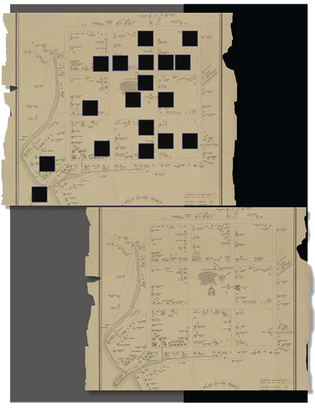
Yale University Library
At right is a plan of New Haven in 1748, showing all its buildings.
Above is a markup by Michael Morand ’87, ’93MDiv. It shows, he says, “some of the places where Black people, enslaved and/or free, lived, worked, worshipped (without recompense, reward, or recognition).” Diversity, it must be acknowledged, has always been one of New Haven’s strongest assets.
View full image
Introduction
My most indelible memory of Connecticut Hall is of sitting in the grass with a friend, our backs to the strong brick wall. We were only a few weeks into our first year at Yale. The Old Campus was green and beautiful. Tourists were strolling through, admiring it. One of them stopped to tell us how extremely lucky we were, to be living in such a place.
It was a seismic emotional shift to learn, late last October, that the brick wall I’d leaned against had been built in part by people who were enslaved. It had never come home to me that New Englanders, let alone my own college, could have endorsed and practiced slavery.
Over eighty colleges and universities have by now investigated or begun to investigate their history with slavery. Yale joined them in the fall of 2020, when President Peter Salovey ’86PhD asked David Blight—Sterling Professor of History, African American History, and American Studies, and a Pulitzer Prize winner—to chair Yale’s examination of its own past. The first meeting took place in mid-November. The research began in earnest early in 2021, gathering steam as more people joined: Yale staff, faculty, librarians, students, alums, members of the New Haven community, experts from other institutions. In all, over 75 people have participated so far.
Blight is the director of Yale’s Gilder Lehrman Center for the Study of Slavery, Resistance, and Abolition (glc.yale.edu). Its mission: “the investigation and dissemination of knowledge concerning slavery and its legacies across all borders and all time.” In late October, the GLC held a three-day online conference on the findings to date (tinyurl.com/YaleAndSlavery-GLC). The articles that follow were excerpted from just a few of the talks given in the conference. (As for myself, I watched almost all the discussions, transfixed. I can’t recommend them enough.)
Blight especially credits the GLC staff who planned and executed the conference—Michelle Zacks, Melissa McGrath, and Daniel Vieira—and Michael Morand ’87, ’93MDiv, communications director at the Beinecke Library, who has been studying the history of New Haven and Yale for years. And the work continues. The team will soon begin writing a book about their findings. In the meantime, the website yaleandslavery.yale.edu has a great deal of information.
The opening remarks were delivered by Salovey, who began by noting how long the historical problem of slavery had been hidden in the shadows. “So today,” he said, “we’re acknowledging that slavery and the slave trade are part of Yale’s history. Our history.” After Salovey’s keynote, Blight held a discussion with poet and writer Elizabeth Alexander ’84, head of the Andrew W. Mellon Foundation; and Jonathan Holloway ’95PhD, former Yale professor and dean of Yale College, and now the president of Rutgers. “I admire institutions that are unafraid of their pasts,” Holloway said.
At the conclusion of the conversation, Alexander read an excerpt from her epic poem about the Amistad captives. It centered on James Covey, a West African who had himself been captured but became a free man. When Yale professor Josiah Willard Gibbs Sr. went to the docks in 1839, looking for someone who knew the captives’ language, he found Covey. In Alexander’s poem, Covey remembered “an infinity of ships fatted / with Africans, men, women, children / as I was. Now it is my turn to rescue.”
It’s now Yale’s turn to examine its past.
Kathrin Day Lassila ’81, editor
 loading
loading